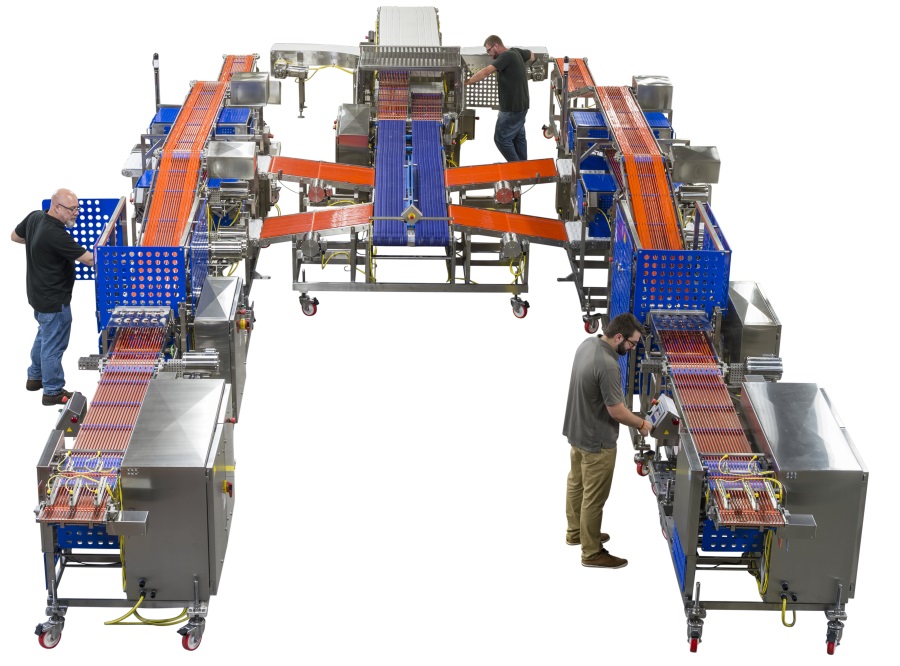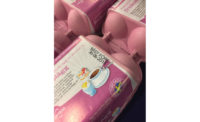The U.S. pork bacon market is growing at an unprecedented rate. In fact, the U.S. pork bacon market accounted for $3.3 billion for the 52 weeks ending April 28, marking a rise from $3.1 billion the previous year, according to figures from National Pork Board, Des Moines, Iowa, compiled by Nielsen Research, New York.
This substantial growth in the market is fueling a demand for meat processors to provide a higher production volume of raw bacon for use in the retail and foodservice industries.
To capitalize on this demand, meat processors are turning to newer, higher-speed packaging solutions that come equipped with dedicated interleavers and card dispensers. By including automated stacking, the equipment also eliminates unnecessary labor costs while reducing the risk for injuries due to repetitive motion.
Dedicated, high-speed interleavers
Interleavers are automated, high-speed machines designed to dispense sheets of paper, film or cardstock under, between or around meat, cheese and other products for portion control, inventory control and sanitary handling. This includes greaseproof paper, parchment paper, plastic film or bacon boards added after slicing and before final packaging.
For raw bacon used in foodservice operations, including restaurants, interleaved paper is often used to separate bulk portions of sliced bacon. The alternative is to pack raw bacon as individual slices side-by-side on paper, a process called lay-flat packaging. In both cases, interleavers are often combined with counter/stacking modules that automatically count and stack the portions for boxing or gas flush packaging.
For raw bacon packaged for retail sale in grocery stores and other outlets, packaging typically involves the use of interleaved cards, or L-boards, which come pre-printed and branded with product and nutritional information. The process begins with the bacon being sliced and shingled in specific units of weight, followed by the L-board, then being interleaved and folded over the top of the product. The final step involves vacuum-sealing the bacon in clear plastic.
The need for speed
In the production line, the interleaver operates between the slicer and the final packaging equipment, with the slicer typically capable of the highest processing rates. Although this speed imbalance is generally acceptable, there are times when a processor needs to achieve higher packing speeds to satisfy an increase in demand.
This means the interleaver or packaging equipment, whichever is slower, effectively dictates the maximum throughput speed. If these systems are older or poorly designed, they can quickly become a bottleneck. In cases like these, the options are to add more slicing lines or replace the equipment with models that run faster.
“The bottleneck [in bacon processing] is usually with the interleaving or packaging equipment,” says Bernell Martin, president of John F. Martin & Sons, Stevens, Pa. “So, when the process needs to move faster, it usually means switching out equipment to generate that speed.”
John F. Martin & Sons operates five packaging lanes, three with dedicated interleavers for L-Boards. Previously, the maximum throughput rate was only 38 boards per minute, but due to increasing demand, the company needed to increase to at least 54 boards per minute.
After some research, John F. Martin & Sons installed a ProLeaver Card Dispenser from Packaging Progressions, a Souderton, Pa.-based manufacturer of automatic, high-speed interleavers, stackers and card dispensers.
The ProLeaver Card Dispenser delivers exceptionally high throughput speeds, and can feed up to 80 cards per minute without losing time to jams, missed cards or double feeds.
John F. Martin & Sons also sells bacon to foodservice operations. This requires traditional paper-feeding interleavers. Based on a sheet-weight of ½-pound of raw bacon, the equipment can interleave up to 120 sheets per minute for a total of 3,600 pounds of lay-flat bacon per hour – nearly twice that of traditional systems.
To achieve these kinds of speeds and maximize uptime, Packaging Progression’s interleavers vary from standard industry offerings with unique features such as servo-controlled product and paper synchronization; power-assisted paper unwinds; encoder-enabled positioning for precise placement and jam-free diverting; bacon debris filtering to prevent false paper feeds and reduce jams; paper saving draft presence sensing; jam-detection logic to reduce paper jams; an automatic portion centralizer; and high-speed, servo-controlled vertical diverters for stacking.
These design improvements essentially increase the accuracy and tracking of the items as well as the inserted paper or card to achieve high speeds reliably without double-feeds or paper jams.
“For paper feeders, it is critical they do not jam, which some are known to do,” says Martin. “So, run speeds are important, but so is the amount of uptime. It can’t be a maintenance nightmare.”
Automating manual processes
Despite the available automated equipment, there still are several areas where manual labor is still often utilized in the bacon packaging process. By automating these steps, meat processors can reduce labor costs as much as 90%, eliminate repetitive motion injuries and increase throughput.
For example, when packaging bacon for retail after the L-board is inserted and folded over, the product must often be manually rotated, so it enters the packaging machine at the proper orientation.
“Typically, sliced bacon is loaded onto L-boards in only one direction,” says Martin. “With most equipment, that means someone has to manually rotate the product 90 degrees, so it loads properly into the packaging machine.”
This is spurring the development of equipment solutions, including an automatic folder/turner model.
In many processing plants, the counting and stacking of lay-flat bacon into boxes is still performed manually as well. Once the bacon is sliced and automatically positioned on each sheet, it must be stacked perfectly straight, front to back. The process often requires several workers, and is extremely taxing for both workers and the bottom line.
Instead, automatic stackers can replace this manual step while eliminating the “bunching” often associated with “hand catch stacking.” To that end, high-speed models are capable of counting and auto stacking up to 120 sheets per minute.
Customization
Whether to increase production rates or just to speed time to market, even “minor” design features or details can speed the process and reduce waste.
For example, interleavers can be programmed so paper or L-boards are only inserted when bacon is present to reduce waste. Downgrade diverters that work with most “vision” slicers can also be used to communicate with interleavers to hold off on sending paper and divert bacon scraps and other irregular slices, so they are not combined with high-quality cuts.
Integrated barcode scanners on the card dispenser ensure the right L-board is being dispensed, so regular bacon is not inadvertently being packaged as “low-sodium bacon.” This can prevent costly re-packaging and even product recalls.
Even an established product like bacon can require an interleaver/stacking system with minor design features or customizations to work properly between slicer and packaging equipment.
“If I buy an off-the-shelf board loader from a company, I have to use it as-is,” says Martin. “The difference with a company like Packaging Progressions is they don’t just sell a piece of equipment, they sell a solution. I can tell them, ‘Here's my slicer and here is my packaging machine. I need you to take the product from here to here.’ And, they design it.”



